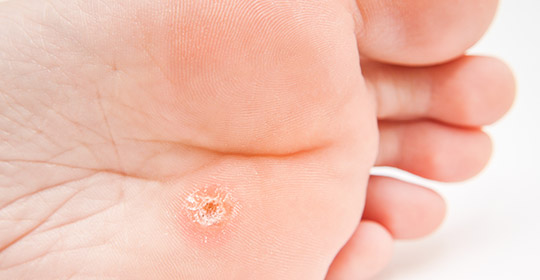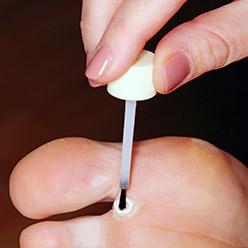Plantar warts
Warts are small, greyish, bumpy growths that form on the surface of the skin and usually measure a few millimetres in diameter. They are caused by a virus of the human papillomavirus (HPV) family and are very contagious.
Unlike common warts, which affect the fingers, hands, face and back, plantar warts develop on the soles of the feet and are flat and hard since they grow inward due to the pressure created by walking. They can sometimes be painful.

How do they spread?
- By direct skin-to-skin contact with an infected person
- By indirect contact with objects that have touched infected skin (e.g. sandals, bath towel)
The virus thrives and spreads more easily in humid environments (e.g. around pools, public showers, beaches, gyms).
Preventive measures
To avoid developing or spreading warts, follow these preventive measures.
- Do not share a towel with someone who has warts.
- Never walk barefoot at the pool or in public showers.
- Disinfect with alcohol any object that has been in contact with warts.
- Do not scrape warts or make them bleed.
- Always wash your hands after touching a wart.
- Apply a bandage to warts being treated.

Treatment options
While many warts will eventually disappear on their own, you can consult a doctor or dermatologist to have them treated. This can help you avoid spreading them to other family members. There are also several over-the-counter wart removal products available; most are formulated with salicylic acid.
Products containing salicylic acid
- To maximize the effectiveness of products formulated with salicylic acid, start by soaking your feet in warm water for 5 to 15 minutes. Gently file the wart with a pumice stone. Apply the product.
- Make sure you apply the product only to the wart. Try using petroleum jelly (e.g. Vaseline®) or clear nail polish on surrounding skin.

There are also secondary treatments, such as liquid nitrogen, available without a prescription. Over-the-counter foot products are safe and effective when used as directed. However, they may not be suitable for some people, including those with diabetes. Before using this type of product for the first time, talk to your family pharmacist. He or she can give you advice on their use, precautions and contraindications.
When to see a doctor
It is best to see a health professional in the following cases:
- If you are not sure it is a wart
- If a wart persists, multiplies or returns after treatment
- If a wart is painful or bleeding
- If a wart affects the shape of a toenail
- If there are signs of infection
Laser removal, electrocoagulation and surgery are other treatment options that may be recommended to you.
Pharmacy services
Do you have questions on plantar warts and over-the-counter treatment options? Speak with your family pharmacist for answers!
The pharmacy services presented in this section are offered by pharmacist owners who are affiliated with Uniprix. The pharmacists are solely responsible for the professional activities carried out during the practice of pharmacy. These services are offered in participating pharmacies only. Certain fees and conditions may apply.
* The information contained herein is provided for informational purposes only and is not intended to provide complete information on the subject matter or to replace the advice of a health professional. This information does not constitute medical consultation, diagnosis or opinion and should not be interpreted as such. Please consult your health care provider if you have any questions about your health, medications or treatment.
